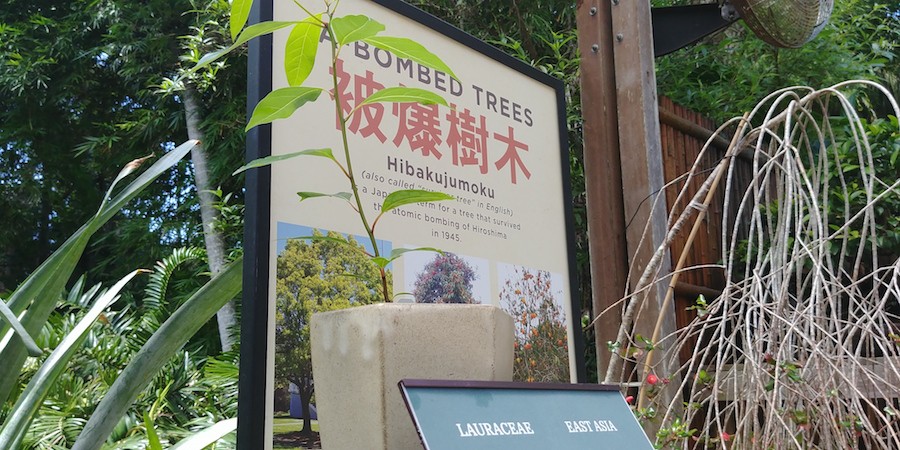Selby Shows Seedlings From Hiroshima
Arts & Culture
SRQ DAILY FRIDAY WEEKEND EDITION
FRIDAY AUG 4, 2017 |
BY PHILIP LEDERER
Pictured: Camphor seedling at Selby Gardens. Photo by Phil Lederer.
When the US military dropped the atomic bomb on the city of Hiroshima on August 6, 1945, near 90,000 people died instantly. Many more would follow in the days, weeks, months and years to come, as the survivors rebuilt their city. But in the wreckage of a blast radius boasting a mile of total destruction, they found hope as well, in the sturdy trunks and slender branches of the trees still standing. Established in 2011, Green Legacy Hiroshima spreads this hope—and the cautionary tale contained therein—through seeds harvested from these surviving trees and sent across the world. Now some of those seeds have found there way to Selby Gardens, where, through the month of August, visitors can view the budding seedlings as they begin their lives in Florida climes.
Thanks in large part to a partnership with New College of Florida, the opportunity came to the attention of Selby Gardens through New College Assistant Professor of Religion Dr. Manuel Lopez Zafra, who, on a recent visit to Japan, was struck by Green Legacy’s mission and its meaning. "They had a powerful message of remembrance, to remember what happened to Hiroshima and the consequence of war," he says. "But also this message of optimism—the idea that these seeds are living reminders but also symbols for peace." Working with Selby Gardens, which holds a USDA import license, in addition to considerable horticultural expertise, the institutions arranged for the delivery of several holly, persimmon and camphor seeds, to be shared between the two organizations.
Standing roughly six inches tall at this point, the persimmon and camphor seedlings are now on display at Selby Gardens, but the holly remains hidden in the greenhouse. Incredibly hard seeds, the plant growing inside can take up to a year to break through, and only then will Selby Gardens staff know what they have, but Dr. Bruce Holst, director of botany, thinks that at least one has germinated and will grow.
Though there are certainly plenty of political questions surrounding the use of the atomic bomb in World War II, Selby Gardens is steering clear of that particular conversation with this exhibition. “We’re just honoring the plants,” says Holst. The trees’ astounding resilience, surviving the blast and aftermath of an atomic bomb, makes them almost wonders of the natural world. So far, the camphor and persimmon seedlings appear healthy, which is to be expected, he says, and kind of the point. “The possibility exists [of mutation],” says Holst, “but these are developing normally.”
The seedlings will be on display through the month of August, after which the persimmon will be brought back within the protection of the greenhouses until grown to the proper size (“That,” says Holst, pointing to one of the seedlings, “is like breakfast for a rabbit.”) and the camphor sent to Sarasota’s Sho Fu Bonsai Society for training. Eventually, the persimmons will be permanently planted in the Gardens.
On display through August 31; this Sunday, August 6, the seedlings will be available for viewing free of charge for all veterans.
Pictured: Camphor seedling at Selby Gardens. Photo by Phil Lederer.
« View The Friday Aug 4, 2017 SRQ Daily Edition
« Back To SRQ Daily Archive









